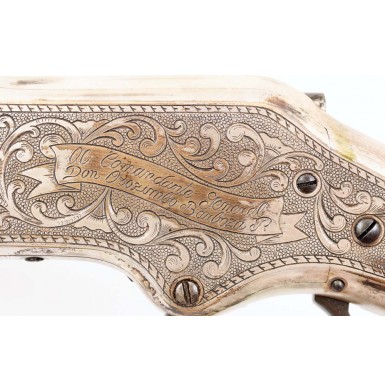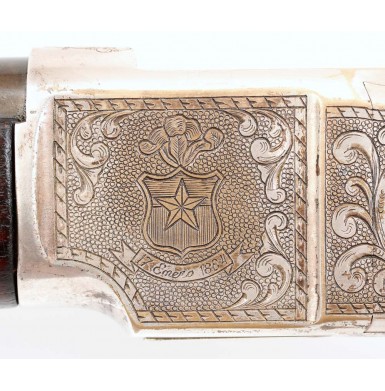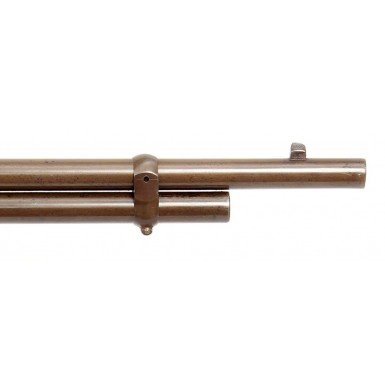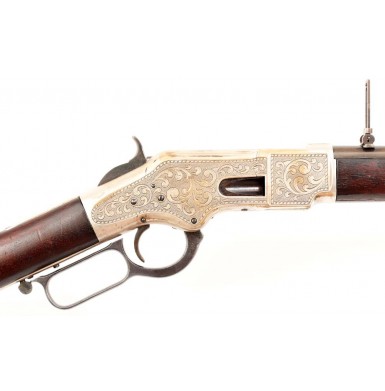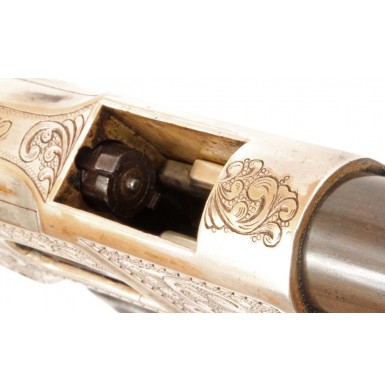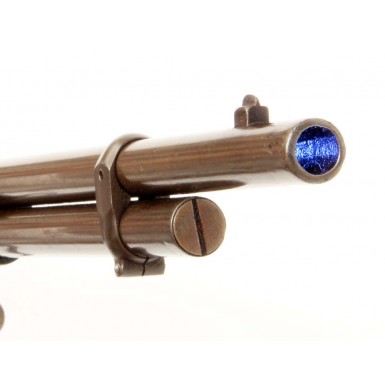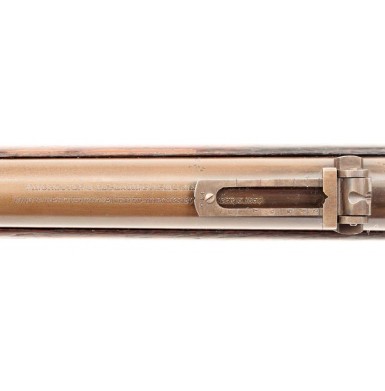Engraved Presentation Winchester 1866 Musket
- Product Code: FLA-3101-SOLD
- Availability: Out Of Stock
-
$1.00
The Winchester Model 1866 “Yellow Boy” is one of the most iconic gun in the history of firearms. The .44 caliber, lever action, repeating rifle was a significantly improved version of the famous Henry Rifle that had first entered production in 1860, as a product of the New Haven Arms Company, who included among its shareholders, Oliver Winchester. The Henry Rifle established itself as a military milestone during the American Civil War, doing service with a number of Union regiments between 1861 and 1865. Although the 16 shot magazine gave the gun amazing firepower in a day when the single shot muzzle loading musket was the standard infantry weapon, its .44 Henry Rimfire cartridge was relatively low powered when compared to a military musket cartridge. The Henry had other drawbacks as well, including the lack of a wooden forend and the method of loading the magazine tube. The front portion of the rifle was made up of a barrel and magazine tube, with no covering. This meant that as the rifle was fired it became very hot and difficult to hold the barrel. The magazine tube was open at the bottom, which meant dirt and debris could enter it and cause feeding problems. The magazine was loaded by pulling a thumb tab, attached to the cartridge follower to the top of the barrel (near the muzzle), compressing the magazine spring and rotating the front portion of the barrel and magazine assembly to allow access to the magazine tube. While this was a major improvement over the single shot muzzle loader, the system meant that you had to be aware of the location of the follower tab as you shot the rifle, as it could hang up on your hand and cause cartridges to feed incorrectly or jam. The problems with the mechanics of the gun were solved in 1866 by Nelson King, who had become the factory superintendent of the newly named Winchester Repeating Arms Company, under the ownership of Oliver Winchester. King’s improvement added a loading gate to the left side of the brass receiver, and enclosed the magazine tube completely. Finally a wooden forend was added to surround the magazine tube and part of the barrel, providing a place to safely grip the rifle while firing. The newly designed Model 1866 went into production the following year. Over the next 30+ years some 160,000 M-1866s would be produced, in rifle, carbine and musket variants. The guns retained their original Henry designed toggle-link action and the .44 Henry Rimfire chambering, but were now a very practical firearm. While most images of the M-1866 center on the American “Old West”, and involve the saddle ring carbine or the rifle, the musket was an important part of the Winchester product line because Oliver Winchester was always hoping to secure military contracts for his arms. Even thought the musket variant of the M-1866 did not go into production until late 1869 or early 1870, in the series known to collectors as “Third Model” 1866s, they had a major influence on military rifle design, especially in Europe. A large number of M-1866 muskets and a smaller number of carbines were acquired by the Turkish military and used to great effect during the Russo-Turkish War of 1877-78, where their rapid-fire capability decimated the Russian forces during the Siege of Plevna. Although the Turks eventually lost the war, the firepower of the repeating Winchester resulted in many European countries developing tubular magazine fed repeating rifles. While the 1866 carbine had a 20” barrel as standard and the rifle had a 24” barrel as standard, the military musket had a 27” round barrel, with the 24” magazine tube of the rifle. It had 3 barrel bands, sling swivels and could mount either a socket bayonet (standard) or a saber bayonet. Most estimates place the production of 1866 Muskets at somewhere around 14,000 units, and Winchester historian George Madis notes that only about 1 in 14 of the muskets (1,000 or less) were equipped to accept a saber bayonet. While the standard socket bayonet simply slipped over the muzzle and was secured by a locking ring and the front sight/bayonet stud on the gun, the saber bayonet required a special bayonet lug that was mounted on the upper barrel band on the right hand side of the barrel. The lug had a screw that secured it to the band and also entered a locating detent hole in the right side of the barrel to help stabilize the lug. Today 1866 muskets that are equipped for the saber bayonet are considered very scarce. The M-1866 was also an important arm to Winchester as it started what would become a tradition of engraving and embellishing firearms to a level not previously seen on most American made guns. 1866s provided some of the first canvases for men who would become famous for their engraving, including Gustav Young, the Ulrichs, and L.D. Nimschke. While most of these now legendary engravers had been embellishing arms before the introduction of the Winchester line, it was on the Winchester canvas that they produced some of their greatest and most famous works. For the collector of Winchester firearms, the addition of an engraved example to their collection is a momentous event, and few features make an engraved Winchester more desirable than one that is presentation engraved to an important historic individual.
The Winchester M-1866 3rd Model Musket offered here is just such an engraved, presentation piece. The entire receiver is engraved in a flowing New York style with floral splays and punch dot background shading that is reminiscent of L.D. Nimschke or his shop. The gun is serial number 41192 and was produced in 1870. It was almost certainly ordered by one of the big New York arms retailers like Schuyler, Hartley and Graham, who had the receiver engraved for potential presentation, but left the banner on the left side of the receiver and the top of the receiver blank for a later inscription. The receiver of the musket was further embellished with silver plating, a technique preferred by engravers like Nimschke, as it made the engraving even more striking. The top of the receiver is engraved with only two words: Chile Agradecido or simply “Thankful Chile”. The left of the receiver is engraved in two lines within a presentation ribbon: Al Comandante General / Don Orozimbo Barboza P., or “Commander General / Don Orozimbo Barbosa P(uga)”. The left side of the receiver is also engraved with a version of the Chilean Coat of Arms, which depicts the central plumed shield, but does not include the crowned condor and the crowned huemul that normally appear on the either side of the shield. Underneath the crest the following date is engraved: 17 Enero 1884 (17 January 1884). So, the M-1866 Winchester Musket was presented to Commander General Don Orozimbo Barbosa Puga, from a “Thankful Chile”, with a date of 17 January, 1884.
Barbosa Orozimbo Puga was born on March 5, 1838 in ChilL’n, Chile. He was the son of Juan Barbosa Jiménez (a sergeant in the Chilean army) and Dolores Puga Alvarez de la Barrera. His career in the military was probably pre-ordained by his father’s profession. As a child he attended school in ChilL’n, but in 1856 he secured a commission in the Chilean Army as a lieutenant. In 1859 he faced his first combat, serving with the 1st Battalion of the Chilean Army, fighting revolutionaries who were trying to overthrow Chilean President Manuel Mount. Barbosa Orozimbo would spend the rest of his military career fighting for his country, and in the end would die fighting anti-government revolutionaries, much in the same way he had started his career. As a result of his service during the 1859 revolution, he was promoted to the rank of captain. Over the next decade he spent his time in the army bringing far-flung Chilean regions under the control of the central government and helping to define the boarders of Chile in contested areas, especially near the Bolivian boarder. His military star continued to rise and by July of 1869 he had been promoted to serve as the governor of La Imperial, an ancient Chilean city and present day Carahue. He was subsequently promoted to lieutenant colonel and then to command of the 8th Battalion of the Chilean line infantry. By 1876 he had been promoted to full colonel and in 1879 was placed in command of the Regiment Lautaro. During the War of the Pacific (1879-1883), Barbosa Orozimbo played a major military role for Chile. The war pitted Chile against Bolivia and their ally Peru. The conflict had its roots in an ongoing boundary dispute between Chile and Bolivia over the Atacama region, which was claimed by both countries. Both countries had previously been Spanish colonies and the boarder had been managed by Spain until Chile and Bolivia obtained their independence from Spain in 1818 and 1825 respectively. A treaty in 1866 had temporarily settled the dispute, but it flared up again the early 1870s. The crux of the territorial dispute was over the rich mining in the area, with large deposits of niter, copper and silver. Even after the 1866 treaty has “settled” the dispute, hostilities still simmered, as the Bolivians felt that their loss of the territory not only lost them the minerals, but also the tax revenue from the minerals. A second treaty was signed between the two countries in 1874 to further settle the issue. This time it was agreed that the tax revenue from the minerals obtained in the region would be split between the two countries and that no further taxes would be imposed for a period of 25 years. In 1878 the Bolivian’s violated the treaty and attempted to impose further taxes on a Chilean mining company operating on the Bolivian side of the disputed region. Chile attempted to resolve the issue through mediation, but Bolivia insisted that the issue must be dealt with in Bolivian courts, where the Chileans would certainly not receive any justice. The Bolivians increased the pressure by indicating that should the issue not be resolved, their ally Peru, who had signed a secret treaty to support Bolivia in 1873, would fight against Chile. As the issue came to a head at the end of 1878, Chile sent a warship to the coast of the disputed region and in early 1879 the Bolivian’s attempted to seize the Chilean mining company and its assets. On March 1, 1879 Chile declared war on the combined allied forces of Bolivia and Peru. The war started with a Chilean naval expedition to insure a supply route from Chile to the disputed territories between the two countries. This was especially important due to the fact that much of the disputed land was desert and there was no way for an army in this region to “live off the land”. Barbosa Orozimbo was placed in command of the 4th Division of the Chilean Expeditionary Army and fought at a number of battles as the war proceeded. His men were engaged at the Battle of Islay, the Battle of Tacna and the capture of Morro de Arica, to name just a few of the engagements in 1880. He was subsequently given command of the 2nd Brigade of the 2nd Division of the army, and led his troops in the Battle of San Juan as well as at Chorrillos and Miraflores. The expedition culminated with the attack on Lima, and Barbosa Orozimbo lead his troops into the capital of Peru on January 17, 1881. The capture of the Peruvian capital reduced Peruvian hostilities to a guerrilla war, which the Chilean army contained over the next 18 months, culminating with Chile’s defeat of the Peruvian forces at the Battle of Huamachuco in July of 1883. Barbosa Orozimbo’s success in the campaign to capture Lima earned him promotion to Inspector General of the Army. In 1883 the war with Peru ended, and the Treaty of Ancón was signed on October 20, 1883. Bolivia singed a truce the following year and the war was finally over. On May 9, 1884 Barbosa Orozimbo was promoted to General Commander of Arms of Valdivia and he served in that capacity until 1887 when he was promoted to Brigadier General, subsequently being given the position of General de Armas Santiago. In 1891 he became a senator from Cautín, but that only lasted until a new rebellion broke out that year. Barbosa Orozimbo had always been loyal to the government of Chile, and he remained loyal to the current President Jose Manueal Balmaceda when the civil war erupted. He was appointed to the position of General and Chief of the Army and led the government forces against the rebels. Unfortunately, the “rebels’ were the majority of the country, and with the exception of the Chilean Navy, the majority of the nation’s armed forces had also turned against the government. In an attempt to use force to control the rebels and their supporters, Barbosa Orozimbo was implicated in the Slaughter of Lo Lo Cañas, where a number of anti-government agitators were put to death. On August 21, 1891 General Barbosa Orozimbo lead the government forces at the Battle of Concon (near Valparaiso), where the rebel forces defeated them soundly. During the retreat of government forces to the harbor of Valparaiso, General Barbosa was surrounded by rebel and killed on August 28. During his life Barbosa had been a loyal military servant to the Chilean government for 35 years, fighting heroically for his country, and working his way up the ranks from lieutenant to general. He was considered one of the most modern of the Chilean military officers of the time and was particularly heralded for his advanced use of combined arms tactics, especially combining naval and ground forces for effective attacks.
This engraved Winchester M-1866 Musket was obviously presented to Barbosa after the conclusion of the War of the Pacific, and his promotion to “Commander General” in 1884. The gun was likely purchased in America from Schuyler, Hartley & Graham, where it had been initially engraved, and the salient engraved information was added at the time of its purchase. More than likely the gun was presented to Barbosa by the Chilean government. The date January 17, 1884 does not appear to have a specific meaning, but I believe that it was probably supposed to read January 17, 1881, referencing the taking of Lima, Peru by Barbosa and his forces. The engraver probably made a mistake and used the year 1884 as I assume that was the year it was engraved. It is also possible that the engraved date was meant to reference two different events; the January 17 capture of Lima and Barbosa’s 1884 promotion to Commander General. The musket is in about VERY GOOD overall condition, and appears to be 100% original with no obvious replacement parts. It is one of the scarce 1866 Muskets intended to accept a saber bayonet, but the saber bayonet lug is missing form the upper barrel band. The musket shows substantial use, so it appears that Barbosa probably enjoyed shooting it on a regular basis during the last few years of his life. The gun is well marked throughout, and all of the engraving remains crisp and sharp. There is an M stamped on the left side of the lower tang, hidden beneath the wood. The two line “King’s Improvement” barrel address remains in very legible condition and reads:
WINCHESTER’s - REPEATING ARMS, NEW HAVEN, CT
KING’s IMPROVEMENT “ PATENTED “ MARCH 29, 1866. OCTOBER 16, 1860
The serial number 41192 is clearly stamped in the lower tang of the frame, underneath the lever. The serial number is surrounded by simple engraved enhancements, and similar simple engraved embellishments are present on the upper tang, the bottom of the frame and cartridge lifter, the top of the buttplate and the rear of the lower tang. All of the brass components were silver plated at the time of the embellishment. The frame retains about 20% of this silver plating, most of which is evenly worn. The largest areas of the silver remain in the recesses and protected areas of the frame and along the bottom where the frame saw less handling. The buttplate retains about 50%+ of the silver plating, with the tang being devoid of silver and having a deep, dark, untouched umber patina. The barrel and magazine tube retain essentially none of their original blue, but do have a very smooth and even brownish patina with a plum undertone. The barrel bands all have the same brownish-plum patina, matching the barrel and magazine tube perfectly. The metal is essentially free of any pitting, but does show some very lightly scattered minor patches of pinpricking; this is most evident on the lever. The lever has a deep, dark smoky bluish gray patina, as does the lever catch and the trigger. The hammer retains some muted traces of case coloring and has a similar dark patina as the lever. The loading gate retains about 20% bright blue, with the balance a faded patina of smoky blue gray color. The bore of the musket rates about GOOD+ to NEAR VERY GOOD. It retains strong, deep rifling for its entire length, but also shows moderate oxidation and corrosion along its entire length. Some of this may be accumulated dirt and debris and might be removed with a good scrubbing. A serious cleaning would probably improve the overall condition of the bore. The musket retains its original 900-yard rear sight, which is complete including the elevating slide. The original front sight that could double as a socket bayonet stud is also present. The upper barrel band has a flat on the right hand side and a screw hole, indicating that originally this musket was set up to accept a saber bayonet, but the saber bayonet lug was subsequently removed for some reason. The musket retains both of its original sling swivels, with the upper one on middle barrel band and the lower one in the toe of the stock. The lower swivel shows an old repair to the sling loop, which is somewhat crude but does not detract from the display of this lovely presentation musket. The screws all appear to be original and most retain at least some of the their original fire blued finish, although most show at least some fading and dulling. Most of the screw heads are in decent condition, showing only minor slot wear, but a couple of them show more significant damage to the slots. The musket is mechanically EXCELLENT and functions smoothly and correctly in every way. The action remains crisp and there is no reason from a mechanical standpoint why this musket would not be a completely functional shooter, other than the fact that you would go broke buying the antique .44 Henry Rimfire ammunition! The stock and forend are in about GOOD+ condition overall, with the butt rating slightly better than the forend. The buttstock has been lightly sanded, leaving the wood slightly proud of the toe of the buttplate and upper and lower tangs. The buttstock remains solid and complete and is free of any breaks, cracks or repairs. There is some tiny chipping around the lower swivel mount, but this is very minor and does not detract. As the butt has been sanded, it is void of any original finish, and shows some added oil that is not unattractive. The forend shows slightly more wear as is typical. The slender wooden forend of these muskets is often found with cracking and damage due to the thinness of the wood in this region. Several minor grain cracks are present in the forend, and are clearly shown in the photos below. These all have old, internal glue repairs and appear to be stable and solid. There are also a couple of small areas of wood filler present along the upper edge of the right side of the forend, just in front of the rear sight. This area is also clearly depicted below. Like the buttstock, the forend has been sanded, leaving it slightly proud at the frame juncture, and leaving it void of original finish. Some old added oil has left the forend attractive, and the minor grain cracks are do not detract as the forend must be examined closely to see most of them.
Overall this is a very attractive and very interesting Engraved Presentation Winchester M-1866 Musket, of the rare saber bayonet variant. According to Madis less than 1,000 of these “saber muskets’ were ever produced. Interestingly an engraved Winchester M-1866 Saber Bayonet musket, serial number 41187 was sold by James D. Julia in 2011 for $48,875.00. That gun included the saber bayonet and scabbard, and was in somewhat better condition than the musket offered here. The engraving on the gun was attributed to Conrad Ulrich. What is significant about this other Winchester is that it is only 5 numbers away from the musket for sale here, is of the saber bayonet variant and is engraved. This certainly suggests that both guns were purchased by Schuyler, Hartley & Graham and subsequently engraved at their behest. While this gun is certainly not Ulrich engraved, and the engraving is unsigned, it is in the New York style of the era and may well have been done in Nimschke’s shop, or by some other unknown New York engraver working for Schuyler, Hartley & Graham and attempting to copy Nimschke’s style. This presentation engraved 1866 is very attractive and has some very intriguing history behind it. While the War of the Pacific is not well known in the United States, it was a pivotal point in South American history and a major 19th century event. Barbosa was certainly a very important figure in Chilean history and was an important military leader in that country. The opportunity to own an engraved Winchester presented to such an important historical figure rarely occurs, and rarely does the opportunity present itself for less than $20,000! The Ulrich attributed 1866 brought nearly $50,000 and while a spectacular example of the engraver’s art, it has no historical figure linked to it. This is simply a wonderful engrave Winchester 1866 Musket that you will be very proud to add to your collection, and at a very reasonable price. As a good friend of mine says from time to time, “this is a lot of gun for the money”, and is one I know you will be very glad that you purchased. A binder of information regarding Commander General Don Orozimbo Barbosa Puga and the War of the Pacific is included with the gun.
SOLDTags: Engraved, Presentation, Winchester, 1866, Musket




